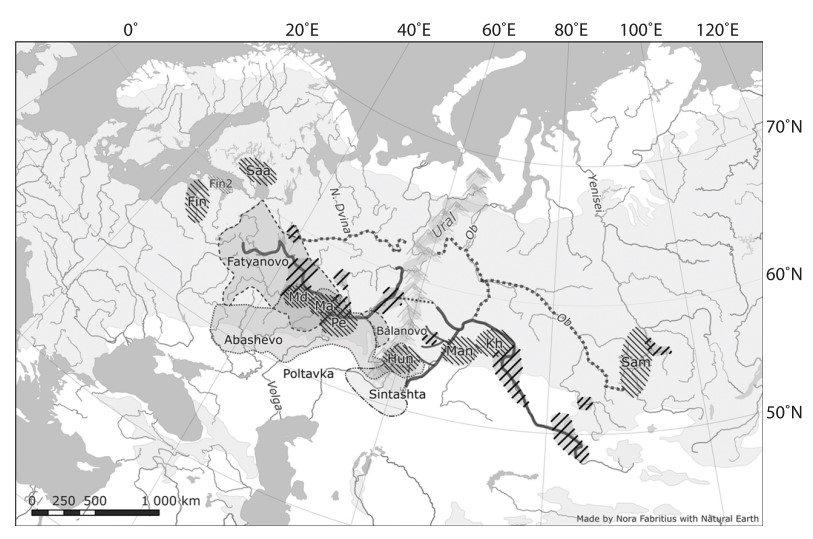The Uralic language family is a few hundred years younger than the Indo-European one, and its spread led to contacts with Indo-Iranian language variants and the creation of a long contact zone in the area currently known as central Russia. Early loan words originating from this contact made their way into the Uralic languages that were beginning to emerge, including Sami, the Balto-Finnic languages, Mordvinic, Mari and the Permic languages.(1)
The spread of the Uralic languages from western Siberia during the early Metal Age happened quickly and chief among the three factors was climate change. During what is sometimes termed the the 4.2ka event, the air in Siberia became colder, spreading outwards to cause widespread droughts and colder winters.

Linguistic and archaeological distributions c. 4,200–4,000 BP. Light shaded band across the entire area: Recent and modern forest zone (steppe to south, tundra to north). Languages and cultures in chronological order: Fatyanovo, Balanovo, Abashevo: Pre-Baltic and Para-Baltic-speaking post-Corded Ware Indo-European cultures. Poltavka, Sintashta: Indo-Iranian-speaking. Shapes with upward coarse parallel hatching: Seima-Turbino major sites. Labeled ovals (finer hatching): core locations of Uralic branch ancestors: Saa(mi), Fin(nic), M(or)d(vin), Ma(ri), Pe(rmic), Hun(garian), Man(si), Kh(anty), Sam(oyedic). Fin2 = later staging ground for Finnic. Heavy line along rivers: southern trade/travel route. Heavy dotted lines: northern route. Light, short dotted line: combined water and overland route across the Urals. (After Saarikivi in press.; Lang 2018; Chernykh 2008.)
The second factor was progress. Though technology is criticized today by activists in academia and the environmental movement, the early Metal and Bronze Age cultures were able to thrive and learn about other cultures thanks to metal, and contact with others and resulting diversity promoted the rapid westward spread of languages. Once trade was established, waterways carried metals from the Ural Mountains and Siberia to the west, as well as later from the Volga to the Baltic region. As technology spread, all lives improved.
In the first stage the Uralic spread went from east to west, and in the second individual branches from south to north. The speakers of the early Uralic languages, in the area bordered by the Volga and its tributaries Oka and Kama, learned agriculture and animal husbandry from their Indo-European neighbours in Europe.
Once the cycle of climate changed again and onditions improved, agriculture spread to the furthest reaches of the northern steppes.
NOTE:
(1) However, they are absent from the Samoyedic languages, the easternmost branch of the language family.






Comments